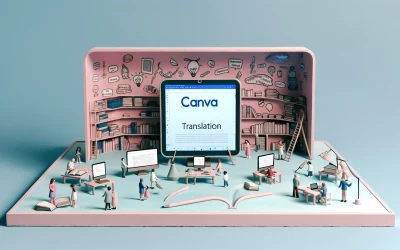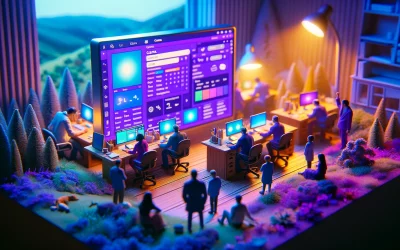Artificial intelligence (AI) has revolutionized the field of photo editing, allowing users to enhance their images with just a few clicks. With AI-powered photo editing tools, users can remove unwanted objects, adjust lighting and color, and even generate new content. These tools are perfect for photographers, designers, and anyone looking to improve the quality of their photos.
Using AI to edit photos is a simple and straightforward process. Users can choose from a variety of AI-powered photo editing software, such as Adobe Photoshop, Luminar Neo, and Canva. These tools offer a range of features and functionalities, from basic adjustments to advanced image processing techniques. Users can also choose from a variety of pre-made templates and presets to speed up their editing workflow.
One of the biggest advantages of using AI to edit photos is the speed and efficiency it provides. With AI-powered tools, users can quickly and easily make adjustments to their images, without having to spend hours manually editing each photo. This not only saves time, but also allows users to focus on other aspects of their work, such as composition and storytelling.
Understanding AI in Photo Editing
AI in photo editing is a game-changer. It uses machine learning algorithms to analyze photos and apply corrections automatically. This could be anything from adjusting the exposure, saturation, or contrast to more complex tasks like object removal and background replacement.
AI photo editing tools learn from large datasets of images to identify patterns and make more accurate adjustments. This means that the more images the tool analyzes, the better it becomes at making adjustments.
One of the benefits of using AI in photo editing is that it can save time. Instead of manually selecting and adjusting different elements of an image, AI can do it automatically. This can be especially helpful when working with large batches of images or when time is a constraint.
Another benefit of using AI in photo editing is that it can help to democratize photo editing. It makes it accessible to a broader spectrum of users, including those who may not have a background in photography or design. With AI, anyone can create stunning images with just a few clicks.
Setting Up Your AI Editing Software
Choosing the Right AI Editing Tool
Before setting up your AI editing software, it is important to choose the right tool that suits your needs. There are several AI-powered photo editing tools available in the market, each with its own unique features and pricing plans. Some of the popular options include Luminar Neo, Topaz Labs, and Adobe Photoshop.
Luminar Neo is a subscription-free software that offers a wide range of AI-powered editing tools and features. Topaz Labs, on the other hand, offers individual models of the software, such as Denoise AI and Sharpen AI, at $79.99 each. Adobe Photoshop is a popular choice among professionals, but it requires a subscription and a steep learning curve.
Installation and Configuration
Once you have chosen your AI editing tool, the next step is to install and configure it on your device. The installation process may vary depending on the tool you have chosen. Most software providers offer step-by-step guides to help you through the installation process.
After installation, it is important to configure the software to suit your preferences. This includes setting up your workspace, adjusting the software’s default settings, and customizing your toolbars. Take some time to explore the software’s features and make adjustments as needed.
Basic AI Photo Editing Techniques
When it comes to photo editing with AI, there are some basic techniques that can help you get started. These techniques include auto-correction features, crop and composition, and adjusting exposure and color.
Auto-Correction Features
Most AI photo editing software comes with auto-correction features that can help you quickly fix common issues in your photos. These features can automatically adjust the brightness, contrast, and color balance of your photos, making them look more vibrant and professional.
Crop and Composition
Cropping your photos is a great way to improve their composition and focus on the most important elements. With AI photo editing software, you can use smart cropping tools that can automatically detect the most interesting parts of your photos and crop them accordingly. This can help you create more visually appealing and engaging photos.
Adjusting Exposure and Color
Adjusting the exposure and color balance of your photos is another important technique in AI photo editing. With AI-powered software, you can use advanced algorithms to adjust the brightness, contrast, and color saturation of your photos, making them look more natural and vibrant. You can also use selective adjustment tools to target specific areas of your photos and make more precise adjustments.
Advanced AI Editing Tools
AI-powered photo editing tools have revolutionized the way people edit their photos. These tools can save you time and effort by automating the editing process and giving you access to advanced editing features that were previously only available to professional photo editors.
Object Removal and Replacement
One of the most impressive AI editing tools is object removal and replacement. With these tools, you can easily remove unwanted objects from your photos and replace them with something else. For example, you can remove a person from a photo and replace them with a tree or a building.
AI object removal and replacement tools work by analyzing the photo and identifying the object you want to remove. The tool then uses advanced algorithms to fill in the gap left by the removed object, making it look like it was never there.
Style Transfer and Filters
AI-powered style transfer and filters are another powerful editing tool. These tools can transform your photos by applying different styles and filters that can change the look and feel of your photos.
With style transfer, you can apply the style of one photo to another photo. For example, you can apply the style of a famous painting to your photo, giving it a unique and artistic look.
AI-powered filters can also enhance your photos by adjusting the color, contrast, and other elements. These filters use advanced algorithms to analyze the photo and apply the appropriate adjustments to make your photo look its best.
AI-Driven Retouching
AI-driven retouching tools can automatically enhance your photos by removing blemishes, smoothing out skin, and adjusting other elements. These tools use advanced algorithms to analyze the photo and identify areas that need to be retouched.
With AI-driven retouching, you can achieve professional-level results with just a few clicks. These tools can save you time and effort by automating the retouching process, allowing you to focus on other aspects of your photo editing.
Working with Layers and Masks in AI
When it comes to photo editing, working with layers and masks is a crucial step to achieve professional-looking results. AI-powered photo editing software offers a range of tools to work with layers and masks that can save time and effort.
With AI masking, users can easily create a mask and a new layer by clicking on the subject or background in the Layers & Masks tool. This feature allows for quick and easy masking on multiple images at once by selecting images in your collection and then clicking Subject or Background. [1]
Another popular feature is the AI layer mask, which allows greater control and fine-tuning of the mask’s properties. Users can refine selected elements with exceptional precision and choose from a range of editing actions to apply to the selected elements. [2]
Layer masking is also useful for making composite images, cutting out objects for use in other images, and limiting edits to part of a layer. It gives users more editing flexibility than permanently erasing or deleting part of a layer.
References:
- AI Masking – Home
- What Is Image Masking And How Is It Used In Photo Editing?
- Photo Layer Editor and Mask AI: Layer Masking In One Click – Skylum
AI for Batch Editing and Workflow Optimization
AI technology has revolutionized the way people edit photos, making it more efficient and effective. With AI-powered batch editing, users can apply the same edits to multiple images simultaneously, saving time and effort. This section will discuss two key features of AI for batch editing and workflow optimization: batch processing and custom presets and profiles.
Batch Processing
Batch processing is a feature that allows users to apply the same edits to multiple images at once. This is particularly useful for photographers who need to edit a large number of photos quickly. With AI-powered batch processing, users can apply complex edits to multiple images in just a few clicks.
One of the most significant advantages of batch processing is that it saves time. Instead of editing each photo individually, users can apply the same edits to multiple photos at once. This means that photographers can spend less time editing and more time shooting.
Custom Presets and Profiles
Custom presets and profiles are another powerful feature of AI for batch editing. Presets are pre-made sets of adjustments that can be applied to images with a single click. Profiles, on the other hand, are sets of adjustments that can be saved and applied to multiple images.
Custom presets and profiles can be used to speed up the editing process and ensure consistency across multiple images. For example, a photographer could create a preset that adjusts the brightness, contrast, and saturation of an image, and then apply that preset to multiple images at once. This would ensure that all the images have a consistent look and feel.
Ethical Considerations in AI Photo Editing
As with any technology, AI photo editing raises ethical concerns that must be considered. The use of AI in photo editing can blur the line between what is real and what is not, leading to questions of authenticity. Additionally, it can raise issues of representation and privacy.
One of the primary ethical considerations in AI photo editing is the potential for manipulation. AI tools can be used to create images that are completely fabricated, which can be misleading and harmful. It is important for users to be transparent about the use of AI in their editing process and to clearly label any images that have been manipulated.
Another consideration is the potential for bias in AI algorithms. If the algorithms used in AI photo editing are not diverse and inclusive, they may perpetuate existing biases and stereotypes. Users must be aware of this potential and take steps to ensure that their editing process is fair and inclusive.
Finally, privacy is a concern in AI photo editing. AI tools can be used to identify and manipulate individuals in images, potentially violating their privacy. Users must be aware of this potential and take steps to protect the privacy of individuals in their images.
Staying Up-to-Date with AI Editing Trends
To stay up-to-date with the latest AI editing trends, it’s important to keep a close eye on industry developments and emerging technologies. One way to do this is by attending AI conferences and events, which provide an opportunity to network with other professionals and learn about the latest advancements in the field. Some popular conferences include the AI Summit, the AI World Conference, and the AAAI Conference on Artificial Intelligence.
Another way to stay informed is by reading industry publications and blogs. There are many online resources that cover AI editing trends, including Medium, Towards Data Science, and Tech Pilot. These publications often feature articles written by industry experts and provide insights into the latest technologies and techniques being used in the field.
It’s also important to keep an eye on emerging startups and companies that are developing new AI editing technologies. Some notable startups in this space include Skylum, Pixelmator, and Luminar. These companies are often at the forefront of innovation and can provide valuable insights into the future of AI editing.




